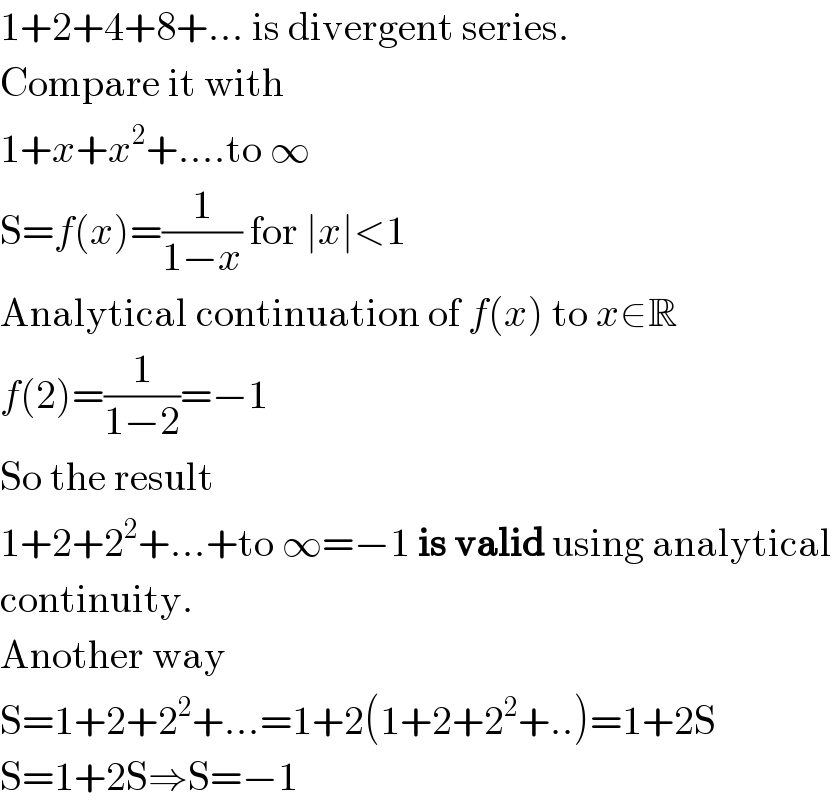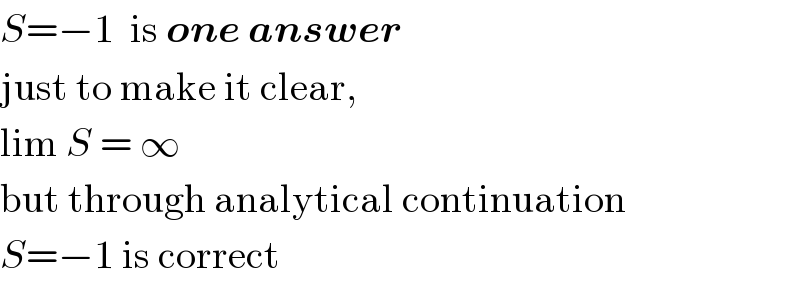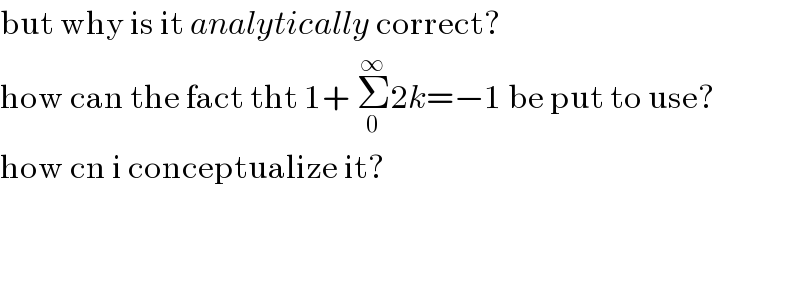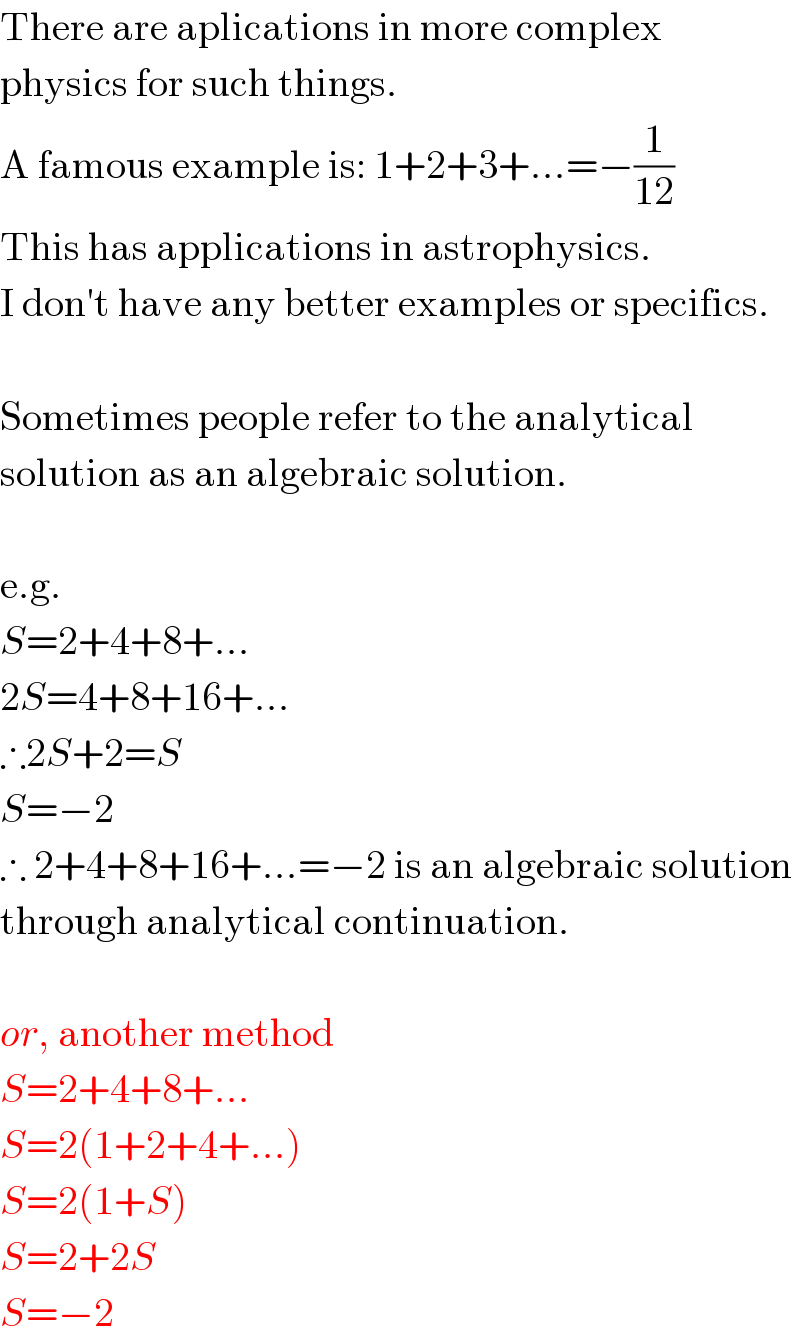
Question Number 5843 by Rojaye Shegz last updated on 31/May/16

Commented by Rojaye Shegz last updated on 31/May/16

$${What}\:{is}\:{wrong}\:{here}? \\ $$
Commented by Yozzii last updated on 31/May/16

$$\infty\neq\infty\: \\ $$
Commented by prakash jain last updated on 01/Jun/16

$$\mathrm{1}+\mathrm{2}+\mathrm{4}+\mathrm{8}+...\:\mathrm{is}\:\mathrm{divergent}\:\mathrm{series}. \\ $$$$\mathrm{Compare}\:\mathrm{it}\:\mathrm{with}\: \\ $$$$\mathrm{1}+{x}+{x}^{\mathrm{2}} +....\mathrm{to}\:\infty \\ $$$$\mathrm{S}={f}\left({x}\right)=\frac{\mathrm{1}}{\mathrm{1}−{x}}\:\mathrm{for}\:\mid{x}\mid<\mathrm{1} \\ $$$$\mathrm{Analytical}\:\mathrm{continuation}\:\mathrm{of}\:{f}\left({x}\right)\:\mathrm{to}\:{x}\in\mathbb{R} \\ $$$${f}\left(\mathrm{2}\right)=\frac{\mathrm{1}}{\mathrm{1}−\mathrm{2}}=−\mathrm{1} \\ $$$$\mathrm{So}\:\mathrm{the}\:\mathrm{result} \\ $$$$\mathrm{1}+\mathrm{2}+\mathrm{2}^{\mathrm{2}} +...+\mathrm{to}\:\infty=−\mathrm{1}\:\boldsymbol{\mathrm{is}}\:\boldsymbol{\mathrm{valid}}\:\mathrm{using}\:\mathrm{analytical} \\ $$$$\mathrm{continuity}. \\ $$$$\mathrm{Another}\:\mathrm{way} \\ $$$$\mathrm{S}=\mathrm{1}+\mathrm{2}+\mathrm{2}^{\mathrm{2}} +...=\mathrm{1}+\mathrm{2}\left(\mathrm{1}+\mathrm{2}+\mathrm{2}^{\mathrm{2}} +..\right)=\mathrm{1}+\mathrm{2S} \\ $$$$\mathrm{S}=\mathrm{1}+\mathrm{2S}\Rightarrow\mathrm{S}=−\mathrm{1} \\ $$
Commented by prakash jain last updated on 01/Jun/16

$$\mathrm{The}\:\mathrm{result}\:\mathrm{S}=−\mathrm{1}\:\mathrm{is}\:\mathrm{correct}. \\ $$
Commented by FilupSmith last updated on 01/Jun/16

$${S}=−\mathrm{1}\:\:\mathrm{is}\:\boldsymbol{{one}}\:\boldsymbol{{answer}} \\ $$$$\mathrm{just}\:\mathrm{to}\:\mathrm{make}\:\mathrm{it}\:\mathrm{clear}, \\ $$$$\mathrm{lim}\:{S}\:=\:\infty \\ $$$$\mathrm{but}\:\mathrm{through}\:\mathrm{analytical}\:\mathrm{continuation} \\ $$$${S}=−\mathrm{1}\:\mathrm{is}\:\mathrm{correct} \\ $$
Commented by Rojaye Shegz last updated on 01/Jun/16

$$\mathrm{but}\:\mathrm{why}\:\mathrm{is}\:\mathrm{it}\:{analytically}\:\mathrm{correct}? \\ $$$$\mathrm{how}\:\mathrm{can}\:\mathrm{the}\:\mathrm{fact}\:\mathrm{tht}\:\mathrm{1}+\:\underset{\mathrm{0}} {\overset{\infty} {\sum}}\mathrm{2}{k}=−\mathrm{1}\:\mathrm{be}\:\mathrm{put}\:\mathrm{to}\:\mathrm{use}? \\ $$$$\mathrm{how}\:\mathrm{cn}\:\mathrm{i}\:\mathrm{conceptualize}\:\mathrm{it}? \\ $$$$ \\ $$$$ \\ $$
Commented by FilupSmith last updated on 02/Jun/16

$$\mathrm{There}\:\mathrm{are}\:\mathrm{aplications}\:\mathrm{in}\:\mathrm{more}\:\mathrm{complex} \\ $$$$\mathrm{physics}\:\mathrm{for}\:\mathrm{such}\:\mathrm{things}. \\ $$$$\mathrm{A}\:\mathrm{famous}\:\mathrm{example}\:\mathrm{is}:\:\mathrm{1}+\mathrm{2}+\mathrm{3}+...=−\frac{\mathrm{1}}{\mathrm{12}} \\ $$$$\mathrm{This}\:\mathrm{has}\:\mathrm{applications}\:\mathrm{in}\:\mathrm{astrophysics}. \\ $$$$\mathrm{I}\:\mathrm{don}'\mathrm{t}\:\mathrm{have}\:\mathrm{any}\:\mathrm{better}\:\mathrm{examples}\:\mathrm{or}\:\mathrm{specifics}. \\ $$$$ \\ $$$$\mathrm{Sometimes}\:\mathrm{people}\:\mathrm{refer}\:\mathrm{to}\:\mathrm{the}\:\mathrm{analytical} \\ $$$$\mathrm{solution}\:\mathrm{as}\:\mathrm{an}\:\mathrm{algebraic}\:\mathrm{solution}. \\ $$$$ \\ $$$$\mathrm{e}.\mathrm{g}. \\ $$$${S}=\mathrm{2}+\mathrm{4}+\mathrm{8}+... \\ $$$$\mathrm{2}{S}=\mathrm{4}+\mathrm{8}+\mathrm{16}+... \\ $$$$\therefore\mathrm{2}{S}+\mathrm{2}={S} \\ $$$${S}=−\mathrm{2} \\ $$$$\therefore\:\mathrm{2}+\mathrm{4}+\mathrm{8}+\mathrm{16}+...=−\mathrm{2}\:\mathrm{is}\:\mathrm{an}\:\mathrm{algebraic}\:\mathrm{solution} \\ $$$$\mathrm{through}\:\mathrm{analytical}\:\mathrm{continuation}. \\ $$$$ \\ $$$${or},\:\mathrm{another}\:\mathrm{method} \\ $$$${S}=\mathrm{2}+\mathrm{4}+\mathrm{8}+... \\ $$$${S}=\mathrm{2}\left(\mathrm{1}+\mathrm{2}+\mathrm{4}+...\right) \\ $$$${S}=\mathrm{2}\left(\mathrm{1}+{S}\right) \\ $$$${S}=\mathrm{2}+\mathrm{2}{S} \\ $$$${S}=−\mathrm{2} \\ $$
